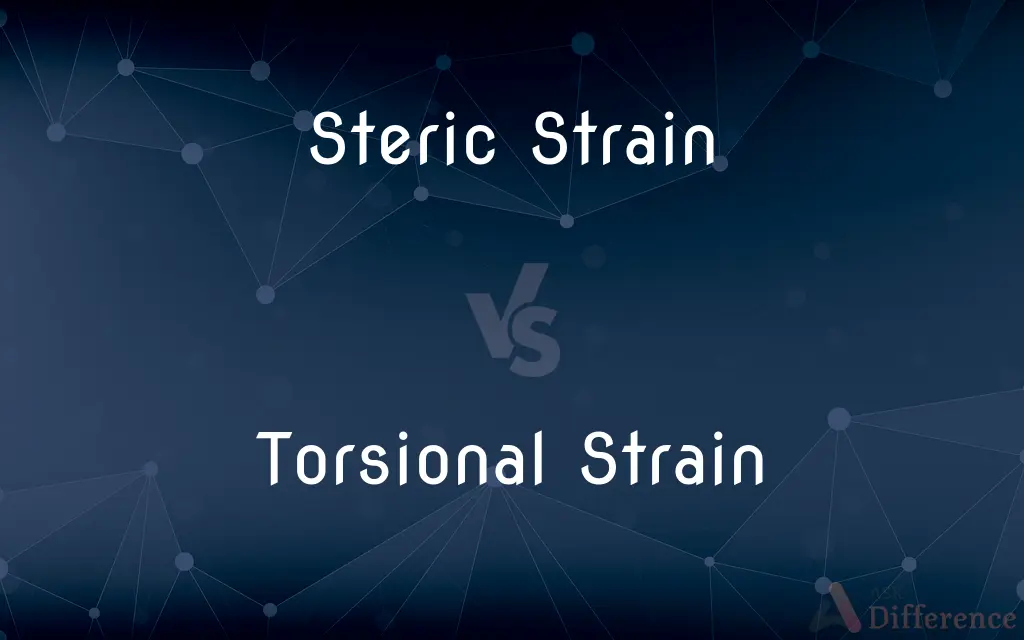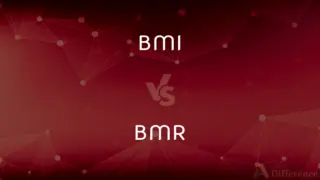Steric Strain vs. Torsional Strain — What's the Difference?
Edited by Tayyaba Rehman — By Fiza Rafique — Published on December 19, 2023
Steric Strain arises from the repulsion of atoms or groups due to their sizes; Torsional Strain results from the repulsion between electron pairs in eclipsed conformations.

Difference Between Steric Strain and Torsional Strain
Table of Contents
ADVERTISEMENT
Key Differences
Steric Strain pertains to the strain induced in molecules because of the spatial arrangement of atoms or groups. This strain comes into play when these atoms or groups are too close together, leading to repulsion due to their sizes and shapes. Conversely, Torsional Strain deals specifically with the repulsion experienced between electron pairs when molecular segments are in an eclipsed conformation.
Analyzing their origins, Steric Strain is generally due to larger groups or atoms in a molecule being in close proximity. When these groups come too close, their electron clouds repel each other, generating strain. In contrast, Torsional Strain emerges when atoms or groups of atoms in a molecule are rotated such that their bonds eclipse one another, causing the electron pairs in these bonds to repel.
From a molecular standpoint, Steric Strain can be visualized as a crowding effect, where bulky groups impede the optimal spatial arrangement of a molecule. This strain forces the molecule into a less stable conformation. On the other hand, Torsional Strain is observed in molecules when their conformations shift in a way that the atoms or groups eclipse each other, thereby leading to an unstable and high-energy state.
When addressing their impact on molecular stability, Steric Strain often results in a molecule adopting a configuration where the repelling groups are as far apart as possible. This reconfiguration aims to minimize the strain and achieve greater stability. In contrast, molecules typically aim to alleviate Torsional Strain by adopting staggered conformations where the repelling electron pairs are further apart.
Speaking of their significance in organic chemistry, both Steric Strain and Torsional Strain are crucial considerations when evaluating molecular conformations. While Steric Strain arises due to the spatial challenges posed by large groups, Torsional Strain specifically relates to the unfavorable interactions in eclipsed orientations.
ADVERTISEMENT
Comparison Chart
Origin
Spatial arrangement of atoms/groups
Electron pair repulsion in eclipsed conformations
Visualization
Crowding effect of bulky groups
Atoms/groups eclipsing each other
Molecular Impact
Forces molecule into less stable conformation
Leads to high-energy, unstable state
Solution for Minimization
Adopt configuration with repelling groups apart
Adopt staggered conformations
Main Cause
Size and shape of groups/atoms
Rotation leading to unfavorable electron pair interactions
Compare with Definitions
Steric Strain
Discomfort arising from crowding of atoms/groups.
Close proximity of large groups in cyclohexane can result in Steric Strain.
Torsional Strain
Discomfort from eclipsing electron pairs.
Molecules tend to minimize Torsional Strain by adopting staggered conformations.
Steric Strain
Strain from the size and shape of molecular groups.
In certain isomers, Steric Strain can dictate the molecule's overall shape.
Torsional Strain
Hindrance due to electron repulsion in rotated configurations.
The syn-periplanar conformation in butane results in significant Torsional Strain.
Steric Strain
Energy increase from unfavorable spatial configurations.
The proximity of tert-butyl groups can lead to pronounced Steric Strain.
Torsional Strain
Energy increase due to eclipse of atoms/groups.
Rotation around single bonds can lead to Torsional Strain in certain orientations.
Steric Strain
Repulsion due to spatial arrangement of atoms.
Bulky substituents can introduce significant Steric Strain in a molecule.
Torsional Strain
Strain from unfavorable rotational conformations.
Eclipsed conformations in alkanes introduce Torsional Strain.
Steric Strain
Hindrance due to electron cloud repulsions in crowded regions.
Steric Strain can be a deciding factor in molecular reactivity.
Torsional Strain
Repulsion from electron pairs in eclipsed bonds.
Butane exhibits Torsional Strain when its conformations are eclipsed.
Common Curiosities
What causes Steric Strain in a molecule?
Steric Strain is caused by the repulsion arising from the spatial arrangement of atoms or groups due to their sizes and shapes.
Can a molecule exhibit both types of strain simultaneously?
Yes, a molecule can experience both Steric Strain and Torsional Strain depending on its conformation and substituents.
Do all molecules exhibit Steric Strain?
Not all molecules exhibit Steric Strain; it depends on the spatial arrangement of atoms/groups and their sizes.
What is the significance of Steric Strain in organic reactions?
Steric Strain can influence molecular reactivity, and the arrangement of reactants, intermediates, and products.
Which strain arises due to bulky groups in a molecule?
Bulky groups in a molecule give rise to Steric Strain.
How can Torsional Strain be minimized in a molecule?
Torsional Strain can be minimized by adopting staggered conformations where repelling electron pairs are further apart.
Can rotational barriers in molecules be attributed to Torsional Strain?
Yes, rotational barriers often arise due to Torsional Strain in eclipsed conformations.
Is Torsional Strain always unfavorable for molecules?
Generally, yes. Torsional Strain usually pushes molecules into higher-energy, less favorable states.
How is Torsional Strain different from Steric Strain?
While Steric Strain arises from spatial arrangement of atoms/groups, Torsional Strain results from electron pair repulsion in eclipsed conformations.
Which type of strain is associated with eclipsed conformations?
Eclipsed conformations are associated with Torsional Strain.
How does molecular shape relate to Torsional Strain?
The shape and conformation of a molecule can either introduce or alleviate Torsional Strain based on atomic alignments.
Can molecular size influence Steric Strain?
Yes, larger molecular groups can introduce more Steric Strain due to increased repulsions.
Are there ways to experimentally measure Steric and Torsional Strains?
Yes, techniques like X-ray crystallography and computational chemistry can help quantify Steric Strain and Torsional Strain.
Does the presence of Steric Strain affect molecular stability?
Yes, Steric Strain can decrease molecular stability by pushing it into less favorable configurations.
Can Torsional Strain influence chemical reactivity?
Yes, Torsional Strain can affect the energy barriers of reactions, influencing reactivity.
Share Your Discovery

Previous Comparison
Chaff vs. Husk
Next Comparison
BMI vs. BMRAuthor Spotlight
Written by
Fiza RafiqueFiza Rafique is a skilled content writer at AskDifference.com, where she meticulously refines and enhances written pieces. Drawing from her vast editorial expertise, Fiza ensures clarity, accuracy, and precision in every article. Passionate about language, she continually seeks to elevate the quality of content for readers worldwide.
Edited by
Tayyaba RehmanTayyaba Rehman is a distinguished writer, currently serving as a primary contributor to askdifference.com. As a researcher in semantics and etymology, Tayyaba's passion for the complexity of languages and their distinctions has found a perfect home on the platform. Tayyaba delves into the intricacies of language, distinguishing between commonly confused words and phrases, thereby providing clarity for readers worldwide.
















































